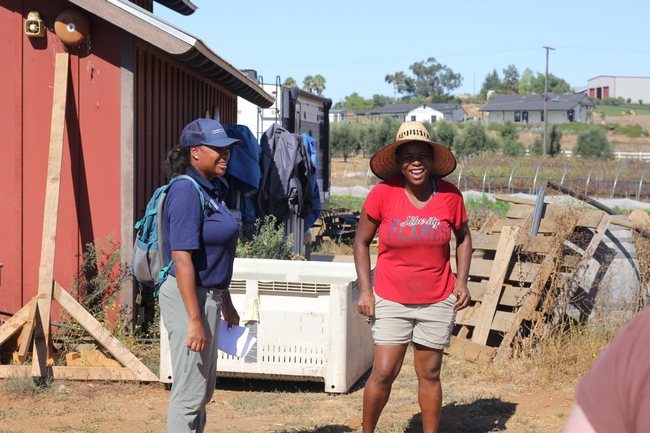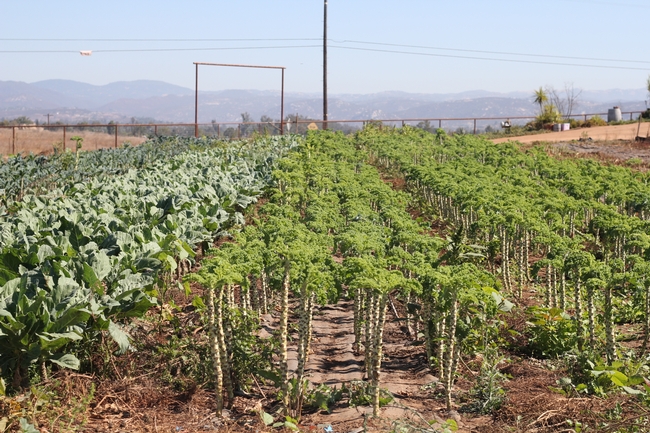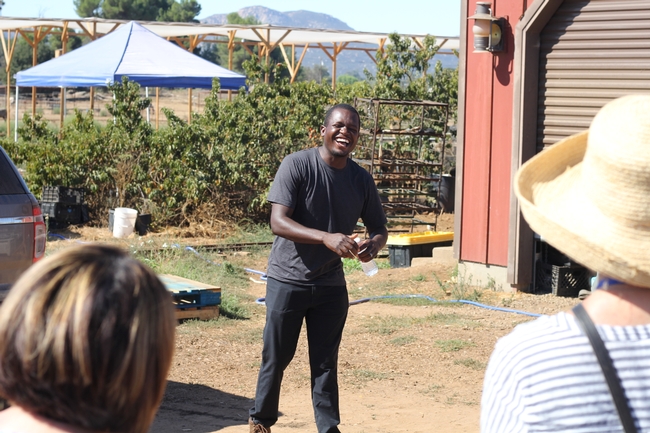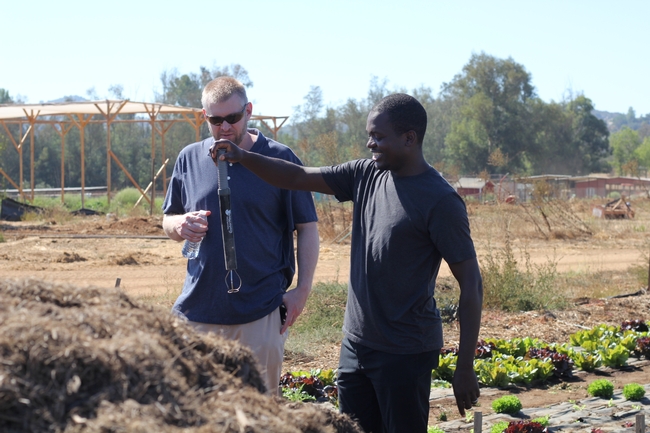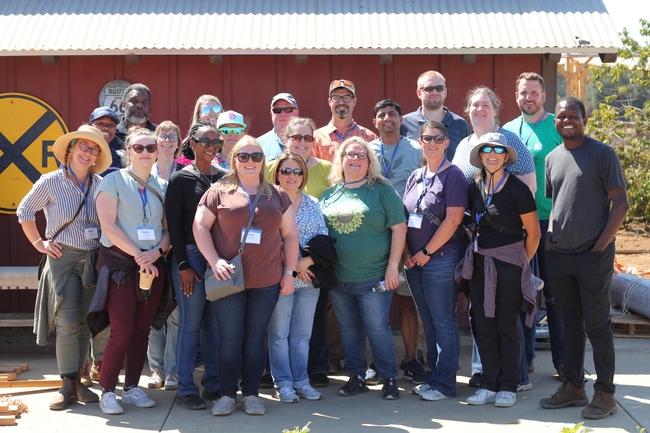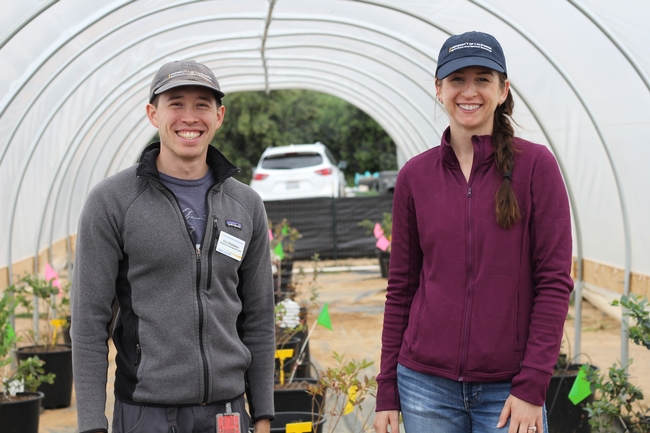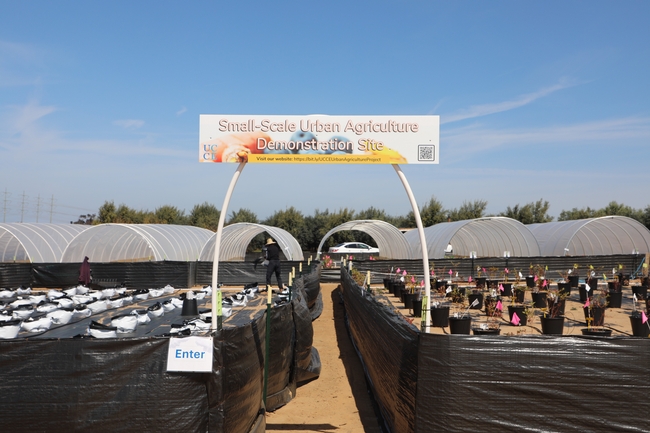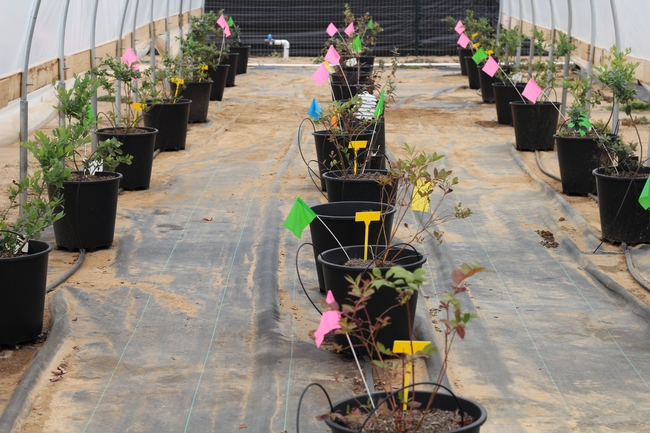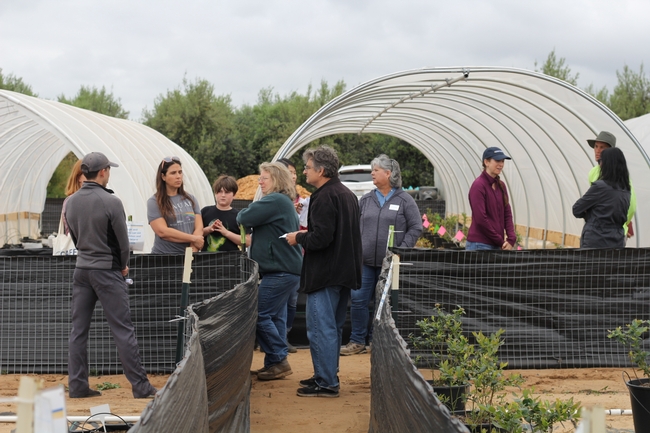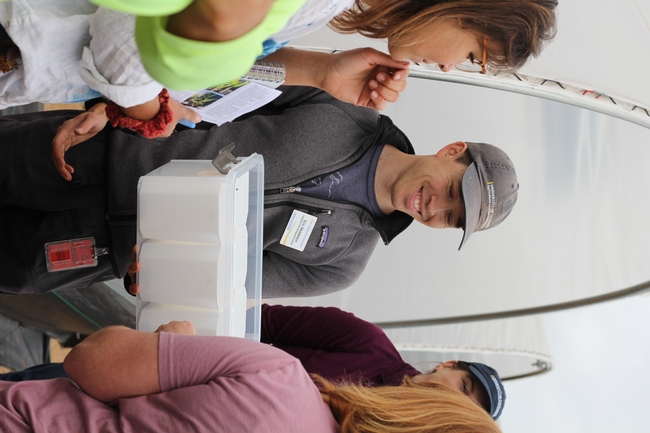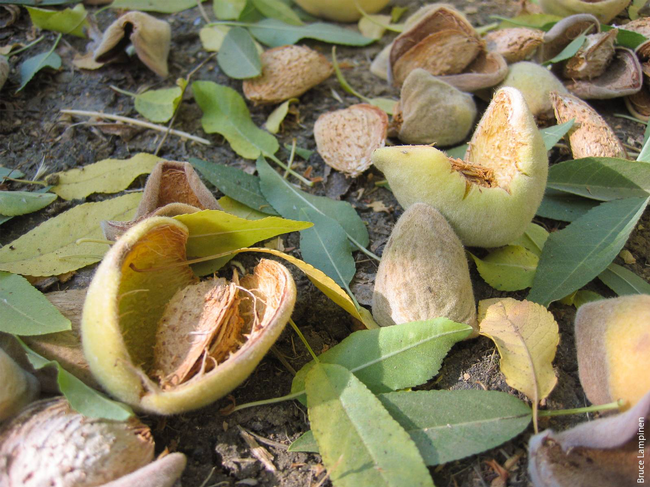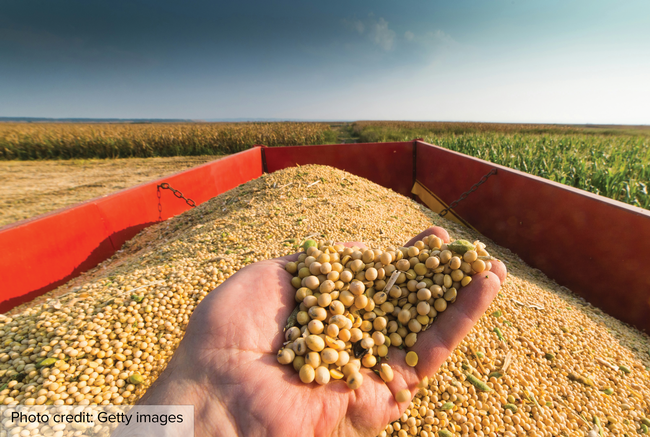Posts Tagged: economic development
UC ANR project to help underserved farmers in SoCal with land ownership
San Diego County has more than 5,000 small farms but less than 2% are operated or owned by Black, indigenous, or people of color – including those of Asian, Hispanic or Native Hawaiian/Pacific Islander descent, according to the 2022 Ag Census.
The reasons vary, but historically, multiple marginalized communities of color have not received the same opportunities or support for land ownership or management as their white counterparts.
Chandra Richards, University of California Cooperative Extension land equity academic coordinator for the Southern California region, is identifying barriers to equity when it comes to addressing land access, tenure, management and opportunities to increase the diversity of land managers and land ownership in the region.
Richards is the principal investigator for the Climate Action and Land Equity (CALE) project administered through UC Agriculture and Natural Resources and funded by the Department of Conservation. CALE aims to engage historically underrepresented communities in coalition building, capacity assessment and climate action planning. CALE elevates knowledge about the challenges and opportunities to land access and management for a diversity of land managers.
Among the challenges is land tenure, an established agreement between a landowner and tenant, outlining the purpose and use of the land over a period of time. However, when landowners decide to sell their land, these agreements are at risk of being null and void, forcing the tenants to renegotiate or discontinue their operation.
Land tenure leases for under five years are considered short-term, which are common in Southern California. For small, new and under-resourced farmers, landowner turnover doesn't just threaten their business plan but their livelihood.
For small farmer Byron Nkhoma, who leases land in Ramona to grow leafy greens and vegetables, the possibility of losing land is a constant worry. Since 2015, Nkhoma and his wife, Joyce, have been renting four of 20 acres to establish Hukama Produce. Over nine years, they have had two landowners. Before the land was sold to his current landowner, Nkhoma said he considered buying land, but the process proved more challenging than he thought.
“What it takes for someone like Byron to find a place to farm and establish a food system is an extremely involved process,” said Richards. “It's not just learning how to obtain land, it's also about managing that land so it can be used for years and generations to come.”
Originally from Zimbabwe, Nkhoma is adamant about taking care of the land he leases and has applied knowledge from his home to ensure resilience. Hukama Produce prides itself in improving environmental health through sustainable farming practices such as compost and mulch application, drip irrigation and low till. An important pillar of the CALE project includes building capacity and providing technical assistance toward land conservation and climate resiliency.
In addition to land tenure, money and time are stressors for small farmers. When they are not working on the farm, Nkhoma and his wife are researching and applying for grants to improve their soils and protect their crops from pests. However, many grants for which Hukama Produce is eligible often have pressing deadlines that demand their immediate attention – cutting into valuable time that could be spent tending to the land or selling at farmer's markets.
Two of Hukama's goals include building and sustaining trust in the market and growing their operation. By partnering with Richards, Hukama Produce has direct access to technical assistance focused on grant writing and conservation to increase ecosystem health and build tenure.
Agricultural land tenure is the arrangement, rights, and responsibilities centered around use, management, and ownership of agricultural land and resources. Building land tenure means that farmers have a stable place to grow their crops and build environmental sustainability without risk of having to move their operations.
While the CALE project boosts support for historically underserved community members hoping to own or manage land, it prioritizes land use for food production as a reinvestment into the greater community.
Eager to bring realities like Nhkoma's to light, Richards partnered with Keith Nathaniel, UCCE director for Los Angeles County, who co-coordinated the Western Extension Leadership Development conference held in San Diego the week of Sept. 23-27. WELD unites Cooperative Extension faculty, agents, advisors, educators and specialists from the western region of the United States for a two-year leadership development program.
While in San Diego, WELD participants joined Richards for a tour of Hukama Produce and learned directly from Nkhoma about opportunities and threats as a small farmer. The tour ended with participants in a circle, sharing how their professional roles can offer support to Hukama Produce and other small farms.
“We grow food so that we can feed the community,” said Nkhoma. “When we feed others, we build relationships. That's what ‘hukama' means – to grow relationships.”
If you operate or know of a small farm in Southern California and would like to be involved with or receive regular updates about the CALE project, please contact Chandra Richards at cmrichards@ucanr.edu.
If you are interested in applying for the Land Equity Project Manager position, please visit https://ucanr.edu/About/Jobs/?jobnum=2894 for details.
Could empty lots be growing food, economic opportunity?
UCCE scientists study feasibility of specialty crops for small urban growers
The vacant lots around your neighborhood could be growing fruits and vegetables and making local produce more accessible – while reducing energy needed to transport and distribute the food. Could turning those empty lots into small farms also become opportunities for economic development?
To answer this question, a team of researchers from University of California Cooperative Extension in San Diego County are investigating the economic feasibility of growing high-value specialty crops in urban settings like vacant lots. The project – led by Eric Middleton, UCCE integrated pest management advisor for San Diego, Orange and Los Angeles counties – is currently in progress at The Flower Fields in Carlsbad, a seasonal attraction for locals and tourists.
Tucked away in the back of the field is the Small-Scale Urban Ag Demonstration Site where Middleton and his team established a small farm on approximately 17,000 square feet, starting fall 2023. Funded by the U.S. Department of Agriculture National Institute of Food and Agriculture, the farm is designed to evaluate containerized production both outdoors and under high tunnels.
Growers don't necessarily need land, just space
High tunnels, also referred to as hoop houses, are semi-permanent structures that act similarly to greenhouses in providing a controlled environment. For the experiment, Middleton will compare cost, effort and durability of two types of high tunnels: one made of steel and the other out of PVC pipes.
“We want to give interested growers information on as many options as we can,” said Middleton, who explained that the project is motivated by the challenges of urban settings, including limited space and lack of arable land.
In the trial, they are growing turmeric, ginger and blueberries. The high-value crops were selected because of their potential to earn a profit. Data evaluating plant variety, soil mix, fertilizer, growth performance, yield and pest and disease pressures will be collected and reported when the project concludes in 2026.
As the crops develop in containers – blueberries in pots and turmeric and ginger in grow bags – Middleton pointed out the mobility aspect of the study, noting that growers don't necessarily need land, just space.
Whether it's a backyard or a rooftop, containerized production means easier transport, especially since vacant land doesn't always remain vacant forever and urban lots may often need soil remediation. Growing in containers solves the anticipated problem of having to relocate.
Where to set up shop in San Diego County
Jan Gonzales, project coordinator and community education supervisor for UCCE San Diego County, is leading the effort to identify available urban land in San Diego County as well as the policies and procedures for growers to access these spaces.
Gonzales is collaborating with community members who are working on similar projects to identify space for prospective growers.
“This has been done before for different objectives and for specific areas in the region, but the information was either project-specific and not publicly available, or not easy to find,” Gonzales said.
Having spoken with people associated with previous or ongoing agricultural land mapping projects, Gonzales has agreed to coordinate and facilitate an advisory work group to discuss areas of potential collaboration and develop project efficiencies. She anticipates holding the first group meeting before the end of the summer.
A production guide to help community members re-create the project
The ideal audience for a study like this is anyone who wants to grow specialty crops, according to Lindsey Pedroncelli, interim director of UC South Coast Research and Extension Center in Irvine, who worked on the project alongside Middleton when she was a staff research associate with UCCE San Diego.
“If you're a new grower or a grower who wants to diversify your crop production, what we're learning here can be applied to you,” said Pedroncelli.
Pedroncelli has been instrumental in bringing the experiment to life and documenting its step-by-step workflow thus far. The production guide, which is being created as the study unfolds, will include instructions detailing how to replicate the experiment from the ground up. Currently, it contains information on how to design your farm, the materials to buy, building structures, irrigation setup and crop management.
The most intriguing open question, whether the operation is profitable, is the driving force behind the production guide and will certainly be addressed, Pedroncelli said.
Book a tour and visit the farm
When visiting the farm, you'll encounter three varieties of blueberries: Star, Snowchaser and Misty. Snowchaser has been a top producer since it was planted in January, but the variety is known to be an early season producer.
Using only one variety of each, the turmeric and ginger were planted in late March-early April. With some unanticipated cold weather in San Diego County, both crops struggled when transitioning out of dormancy, leading to very slow progress, which the team is still navigating today.
Visually, Middleton and his team have noticed differences between the crops growing under the high tunnels versus those grown outdoors, although the data has not been analyzed to confirm or explain notable differences.
Attempting to demonstrate how to profitably grow high-value crops in urban settings using limited space and resources, Pedroncelli said she hopes this study will also encourage people to grow culturally significant crops for their communities.
To tour the Small-Scale Urban Ag Demonstration Site at The Flower Fields in Carlsbad, email Eric Middleton at egmiddleton@ucanr.edu with "Urban Agriculture Demonstration Site Tour" in the subject line.
To learn more about the project and its progress, visit https://ucanr.edu/sites/socalIPM/Small_Scale_Urban_Agriculture_Project_/.
ANR hires expertise in urban pests, plants and small farms
From Siskiyou County through Riverside County, University of California Agriculture and Natural Resources has hired UC Cooperative Extension experts to help Californians address challenging issues.
The eight recently hired UC Cooperative Extension specialists, advisors and coordinators bring expertise in urban pest management, healthy families, regenerative agriculture, plant science, small farms and food safety to their communities.
Since 1914, UC Cooperative Extension researchers have been working directly with community members to improve their lives and livelihoods.
To see a list of UC Cooperative Extension experts who have joined in the past few months, visit https://ucanr.edu/About/DirectorySearch/Recent_Hires. The most recently hired scientists are introduced below.
Lee brings expertise in urban pest behavior to Capitol Corridor IPM role
Sang-Bin Lee joined UC ANR as the urban integrated pest management advisor for the Capitol Corridor – comprising Sacramento, Yolo and Solano counties – to help communities manage urban pests such as cockroaches, termites and ants.
“My high-level hope is to improve public health and the well-being of people in the Capitol Corridor region by implementing and improving the IPM program,” Lee said.
A native of South Korea, Lee earned his bachelor's in biology from Pusan National University. After working in the food manufacturing sector (which included a stint in Brazil, where he learned basic Portuguese), Lee decided to pursue his passion for studying animal behaviors. During his master's program in ecology at Pusan National University, Lee investigated behavioral changes in zebrafish after pathogen infection.
“My goal was to detect fish with symptoms much earlier than conventional methods to prevent the spread of pathogens in fish farms,” he said.
Intrigued by research on social insects, Lee went on to earn a Ph.D. in entomology from the University of Florida, where he studied the social behaviors of termites. Lee has published 34 peer-reviewed articles in professional journals and has received several awards from Entomological Society of America and other professional societies.
He said that he finds urban pest management to be a fascinating discipline – and a very rewarding endeavor – in the field of entomology.
“My interests lie in the behavior of urban pests, and studying their behavior often provides a great opportunity to improve control measures,” Lee explained. “I have had many opportunities to communicate with people from the pest control industry and homeowners; conversations with these people often inspire me to work harder to help those who need my assistance.”
Lee is based in Fairfield, at the UC Cooperative Extension office in Solano County, and can be reached at sablee@ucanr.edu and (530) 574-9835. He is on X/Twitter @SangBinLee4.
New farm advisor Singh to bring latest research to Siskiyou County 
Jagdeep Singh recently joined UC ANR as the agronomy advisor for Siskiyou County. In this capacity, Singh will primarily focus on crop production in alfalfa, pasture and small grains, as well as pest control and water management.
Originally from Punjab, India's agriculture-rich state, Singh brings a unique perspective to his work.
“My passion lies in directly impacting the lives of farmers who feed the world,” he said. “I'm driven by a constant thirst for knowledge and a commitment to bridging the gap between the most up-to-date research and practical, on-farm solutions. What motivates me is understanding farmers' needs and providing science-based answers to their questions.”
Singh earned a B.S. from Punjab Agricultural University, an M.S. from New Mexico State University, and a Ph.D. from Auburn University.
During his Ph.D. studies, he assessed 70 years of cotton breeding impacts on yield, nutrient relations and root architecture, while also studying cover crops for soil health improvement. His M.S. work focused on guar, evaluating its growth, yield, water extraction patterns and water use efficiency under deficit irrigation, as well as identifying cold-tolerant germplasm for cooler regions of the Southern High Plains.
In his new role at UC ANR, Singh aims to build strong relationships with the local community, certified crop advisers and industry groups, leveraging the well-established extension system.
Singh can be reached by email at fgssingh@ucanr.edu or by calling the UCCE Siskiyou office at (530) 842-2711.
Rosenberg joins UCCE as regenerative agriculture farm advisor 
Sara Rosenberg joined UCCE as a regenerative agriculture farm advisor for Mariposa, Merced and Stanislaus counties.
Her disciplinary focuses are agroecology, sustainable nutrient management, and extension research and methodology. Her past research centers on understanding the implications of diversification (with a focus on crop rotations and cover crops) for California rice systems. For her master's program thesis, she conducted a countywide assessment to learn from rice growers about their experiences with crop rotations and understand barriers to adoption, opportunities, and required resources for successful implementation. This two-year study engaged grower communities to help develop research goals for her Ph.D. studies.
Her doctoral research explored how different summer crop rotations affect multiple sustainability factors including soil health, crop yields, weeds, input use and economics. She also assessed different cover-crop species performance in rice environments and their carbon and nitrogen contributions.
She earned a master's in international agriculture development and a Ph.D. in horticulture and agronomy from UC Davis.
Prior to working on her Ph.D., Rosenberg was an agriculture advisor in the Peace Corps for more than three years. She worked closely with smallholder farmers in West Africa, implementing conservation agriculture programs and increasing agricultural resilience in both annual crops and tree crops, mainly in the cashew forestry sector. In California, she has worked on farms for more than eight years, including running her own small, diversified farm in Woodland.
She is passionate about community-led development and using participatory research as a powerful tool for developing sustainable solutions. Her aim is to develop collaborative programming that will support a wide range of farm types, including commercial and small-scale, organic and conventional, annual crops, tree and vine crops, and livestock production systems.
She is developing a robust research program aimed at assessing farm sustainability impact across ecological, agronomic, social and economic factors. She will be collaborating with farmers to help overcome barriers to adopting regenerative practices and build their capacity to advance sustainability goals. Rosenberg also will be developing and promoting tested integrative management practices that increase climate resilience and ecosystem sustainability across diverse farming environments.
Rosenberg is based in Mariposa and can be reached at srosenberg@ucanr.edu and (209) 966-2417 ext. 1417.
Sangha joins UCCE as community water systems advisor 
Laljeet Sangha joined UCCE as a community water systems advisor for Kern, Tulare and Kings counties.
To enhance community resilience, Sangha will lead an integrated extension education and applied research program in water resource management and community development.
He will address critical questions regarding the impacts of environmental stressors, such as chronic long-term droughts, water contamination and increased groundwater demand. Additionally, he will assist in water system consolidations and help communities meet regulatory goals such as those set by the Sustainable Groundwater Management Act (SGMA) and the Irrigated Lands Regulatory Program (ILRP).
Originally from Punjab, India, Sangha earned his undergraduate degree in agricultural engineering from Punjab Agricultural University. He received his M.S. in biosystems engineering from Auburn University and his Ph.D. in biological systems engineering at Virginia Tech.
Sangha's early research focused on the influence of climate variability on ecologically sustainable water withdrawals from streams for irrigation. For his doctoral studies, he evaluated the impact of permit exemptions, climate change and demand growth on water supply. Additionally, he developed methods to quantify unreported water use for crop irrigation.
Sangha also has collaborated on projects in the Colorado River Basin, which explore why the Colorado River no longer reaches the sea. His work includes evaluating the effects of limited water availability on irrigation operations and developing adaptive options for farming communities in the basin.
Sangha is based in Bakersfield and can be reached at lsangha@ucanr.edu.
Beveridge joins ANR's Small Farms team 
Claire Beveridge joined UC ANR as a small farms water-conservation academic coordinator for Fresno, Tulare and Madera counties. She is also part of the statewide UC Sustainable Agriculture Research and Education Program, or SAREP.
As an academic coordinator, Beveridge supports small-scale, diversified and socially disadvantaged farmers in Fresno and surrounding areas in on-farm water conservation through education, technical assistance, outreach and research activities. This encompasses aiding farmers with improved irrigation practices and technologies, groundwater regulation compliance and on-farm groundwater recharge.
She also facilitates small-scale farmer access to state incentives for water and energy efficiency, as well as drought and flood relief programs. Beveridge also helps to inform state water policy on the unique needs of small-scale farms.
She is broadly interested in fostering sustainable water resource management through interdisciplinary and collaborative approaches among communities, decisionmakers and researchers.
Beveridge holds a Ph.D. in civil and environmental engineering with an emphasis in hydrology from the University of Washington. She conducted postdoctoral research at Florida International University and earned her bachelor's degree in civil and environmental engineering from UC Berkeley. She is a licensed Professional Civil Engineer in California, an inaugural editor of the Community Science Exchange journal and resource hub, and recently completed a USDA International Agriculture Education Fellowship in Uganda.
“I grew up in Madera and am excited to be serving my home region as part of UC ANR,” she said.
Beveridge is based in Fresno and can be reached at cbeveridge@ucanr.edu.
Pourkhalili to promote healthy families and communities 
Azin Pourkhalili joined UCCE as a youth, family and community advisor for Kern, Inyo and Mono counties.
In her role, she will promote healthy families and communities by designing, delivering and evaluating strategies for encouraging nutrition and physical activity in youth and their families. Additionally, she will provide academic oversight of community education and outreach program staff who work with families and youth, including the UC 4-H Youth Development Program, CalFresh Healthy Living UC Nutrition Education Program, Expanded Food Nutrition Education Program (EFNEP) and Juntos.
Pourkhalili brings over six years of experience in conducting health intervention research programs, including their development, implementation and evaluation.
Before moving to California, Pourkhalili was a Virginia Cooperative Extension research scientist. She worked on multiple health intervention projects, including nutrition education for older adults through the Elder Nutrition and Food Safety program and the prevention and management of chronic diseases through programs such as the Lifestyle Change Program, Diabetes Prevention Program, Balance Living with Diabetes, and Kick'n Cancer. She also collaborated with the Virginia Department of Health on various projects.
Pourkhalili's academic background encompasses the latest research in nutrition and physical activity education programs, chronic disease prevention programs and health education programs for different age groups. Building on her experience in implementing and evaluating nutrition education programs, her future research aims to address the unique health education needs of diverse communities in California. She plans to continue researching the evaluation and effectiveness of health education programs, such as CalFresh Healthy Living UC, EFNEP and 4-H.
She holds a Ph.D. in human nutrition, food and exercise, specializing in community and behavioral science, and a graduate certificate in gerontology from Virginia Tech.
Pourkhalili is based in Bakersfield and can be reached at apourkhalili@ucanr.edu.
Atume to provide small farms SGMA technical assistance 
Ngodoo Atume joined UC ANR as a Sustainable Groundwater Management Act small farms technical assistance coordinator in the Sustainable Agriculture Research and Education Program.
She will provide technical information, services, policy analysis and recommendations needed to engage and protect small-scale farmers in the implementation of the Sustainable Groundwater Management Act (SGMA).
Before joining UC ANR, Atume worked as a water policy analyst advocating for the implementation of the Human Right to Water in California. She also worked on the inclusion of underrepresented stakeholders in SGMA, Central Valley Salinity Alternative Long-Term Sustainability (CV-SALTS) and the Irrigated Lands Regulatory Program (ILRP).
Born and raised in Nigeria, Atume earned her bachelor's degree in water resources and environmental engineering at Ahmadu Bello University, where her research focused on the treatment and reuse of wastewater. She has a master's degree in sustainable water management from Tufts University.
Atume is based at the UC ANR office in Davis and can be reached at natume@ucanr.edu.
Fujiyoshi joins Capitol Corridor small farms team 
Phillip Fujiyoshi joined UCCE small farms team in the Capitol Corridor as an extension and research associate. Working with Margaret Lloyd, UCCE small farms advisor, Fujiyoshi supports underserved farmers in Yolo, Sacramento and Solano counties by providing them with financial and agronomic technical assistance and making extension materials available in Spanish.
Born and raised in Santa Maria, Fujiyoshi earned his bachelor's degree in biology at the Massachusetts Institute of Technology. His academic knowledge of Spanish transformed into bilingual proficiency thanks to his life experiences of living with Spanish roommates, participating in a tree-planting brigade in Nicaragua and setting up a Spanish-speaking household with a Nicaraguan partner. The Nicaragua trip also sparked his lasting interest in agriculture, leading him into doctoral studies in agroecology at UC Santa Cruz.
After completing his Ph.D., Fujiyoshi performed molecular assays, contributed to phylogenetic studies, and led a spore-trapping field study in a lab studying grapevine trunk diseases. In addition, he pursued outside interests in agriculture, including winning an individual grant to study cabbage aphid behavior, pursuing informal cover crop trials in a community garden plot, volunteering on the UC Davis Student Farm, and giving agronomic advice to growers at the farmers market.
Fujiyoshi is based in Woodland and can be reached at (530) 666-8143 and pfujiyoshi@ucanr.edu.
New project aims to use farm waste to fuel bioeconomy
UC ANR to help create database, support technology for sustainable bioproducts and biofuels
In California's Northern San Joaquin Valley, crop leftovers such as almond shells, fruit peels and orchard trimmings can potentially be converted into sustainable bioproducts and biofuels – with the right technology. The philanthropy Schmidt Sciences' Virtual Institute on Feedstocks of the Future, which supports replacing fossil feedstocks with renewable biomass sources, has awarded new funding to a group investigating how to make better use of the diverse agricultural waste in the region.
“This is an important project for California as it quantifies the diverse ‘ingredients' in the North San Joaquin Valley available to fuel the emerging biomanufacturing industry in the state,” said Gabe Youtsey, chief innovation officer for the University of California Agriculture and Natural Resources. “This foundational work will kickstart a completely new innovation bioeconomy in the Central Valley that will create new high-paying jobs for our communities and support a resilient food and agriculture industry through circular biomanufacturing.”
Circular biomanufacturing is a process that uses waste streams as raw materials to create new products.
“Circular means taking waste streams from agriculture such as almond shells or grape pomace, forest waste or food processing waste and using that material as the ‘feedstock' in a fermentation tank to create new bioproducts,” Youtsey explained.
The group, “Building the Circular Bioeconomy in the North San Joaquin Valley” or BioCircular Valley, is co-led by the Department of Energy's Lawrence Berkeley National Laboratory (Berkeley Lab), UC Berkeley, and BEAM Circular, with partners at UC Merced, UC Agriculture and Natural Resources, the Almond Board of California and USDA Agricultural Research Station in Albany.
“California has this incredible diversity of materials, but they aren't well understood – and this makes it difficult to know how to extract the most value out of them,” said Corinne Scown, a senior scientist at Berkeley Lab and UC Berkeley and one of the project leads. “We want to characterize them and make that information available so companies can more easily figure out which feedstock is a good match for them, and then use that agricultural residue to make everything from bio-based polymers and chemicals to sustainable materials and aviation fuels.”
One of the group's goals is to build a publicly accessible database and user-friendly map full of information about different feedstocks, the raw plant materials and biomass that can be broken down and used to make bioproducts. That includes where feedstocks are located, when they are available, how they are currently disposed of, how they perform in different bioreactors, how much sugar or lignin they contain, whether they can be processed with other feedstocks, their greenhouse gas footprint, the potential cost, and much more.
UC ANR's role is to collect data on available feedstocks from forest, agricultural and food processing byproducts, as well as municipal waste streams through sampling and observation.
“We will do this through the extensive knowledge and relationships we have with the California agriculture industry in the North San Joaquin Valley,” Youtsey said. “UC ANR will also support industry outreach as new ‘conversion' technologies are developed, to pilot them with California growers and processors.”
The project will also test ways to improve the flexibility of the conversion process, which breaks down feedstocks to prepare them to make bioproducts. Researchers will apply artificial intelligence to their lab-generated data to improve predictions of how feedstocks can be processed most efficiently or blended together. Being able to use the same technique on different (or mixed) kinds of plant matter would open up ways for companies to make bioproducts more easily.
“Our region has a fantastic combination of diverse and large-scale agricultural activities alongside manufacturing expertise, making this a great place to scale up bioeconomy innovation,” said Karen Warner, CEO of BEAM Circular. “This project will allow us to reduce barriers to using our region's abundant waste streams in more sustainable and valuable ways, so that we can create the products that people need with renewable inputs that are better for the planet.”
The project builds on ongoing efforts to establish biomanufacturing capabilities in the northern San Joaquin Valley, which includes San Joaquin, Stanislaus and Merced counties. Providing better data on how to convert the valley's millions of tons of agricultural waste into valuable products may spur biomanufacturing companies to build facilities nearby, minimizing how far the raw materials have to be moved and generating new jobs.
“This project is designed to benefit a region that has massive potential, but so far has been economically left behind, and to develop a new industry that can provide improvements in air quality, water quality and greenhouse gas emissions as well as significant opportunities in economic equity and the creation of new jobs,” said Blake Simmons, director of Berkeley Lab's Biological Systems and Engineering Division and the BioCircular Valley project lead.
“This kind of research started as basic science, and now we're bringing information and solutions to people who can use them. And the knowledge generated through this project will advance not only the ability of the NSJV to make use of its own regionally available future feedstocks, but will also accelerate the understanding of feedstocks relevant across California and across the U.S.”
The new funds for the project come from the Virtual Institute on Feedstocks of the Future, a partnership between Schmidt Sciences and the Foundation for Food & Agriculture that supports collaboration on research to transform biomass into alternative feedstocks for biomanufacturing. The award is one of five announced today, which total $47.3 million over five years. It is expected that the five teams will collaborate to share best practices and knowledge to boost the bioeconomy at the national level.
“We are grateful for Schmidt's generous support that will help deploy advanced technologies on the ground,” said Alicia Chang, interim president of Berkeley Lab Foundation. “The foundational research and expertise developed through work for the Department of Energy sets the stage for this team to apply their capabilities to bring jobs and lift the community and the economy in the Northern San Joaquin Valley.”
The unintended consequences of clean fuel policies
How policies affect emissions, land use, and the prices of fuel and vegetable oils
Over the last two decades, both the federal government and state governments have enacted policies to reduce greenhouse gas (GHG) emissions in the transportation sector. In a new Special Issue of ARE Update, University of California agricultural economists explore how these federal and state renewable fuel policies have affected biofuel production for motor and aviation fuels and consider how these policies have affected land use and food prices. Their research shows that as U.S. demand for renewable diesel began to outpace supply, consumer prices for vegetable oil—which is used as a feedstock for renewable diesel—surged.
The national Renewable Fuel Standard (RFS) and California's Low Carbon Fuel Standard (LCFS), implemented in 2006 and 2011, respectively, have led to an increase in the amount of biofuels consumed and produced in the United States. While the RFS mandates that a minimum volume of renewable fuels be blended into U.S. transportation fuels, the LCFS sets an annually increasing targeted reduction in transportation-related carbon emissions. The LCFS set a 2030 target date to reduce GHG emissions by 20% through the development of a carbon trading program that requires refiners who produce ‘dirtier' fuels to buy credits from those who produce cleaner (e.g., renewable) fuels.
The authors show that after 2020, whenLCFS credit prices (i.e.,biofuel subsidies) were high, California saw an increasing volume of motor fuel coming from renewable diesel — which previously only made up around 5% of the state's diesel blend. Currently, the retail diesel blend in California is 35% conventional diesel and 65% renewable diesel.
By 2023, renewable diesel was the most consumed renewable fuel in California and also generated the most credits under the LCFS. Because renewable diesel is a perfect substitute for “conventional diesel,” it does not need to be blended with conventional diesel, unlike biodiesel which is chemically different from renewable diesel.
The agricultural inputs used to make renewable diesel can be used not only in the production of motor oil, but also in the development of sustainable aviation fuel (SAF). Additional tax credits set forth in the 2021 Inflation Reduction Act aim to bring about a 100-fold increase in the production of these fuels by by the end of decade. However, the authors of the second article show that current incentives to produce SAFs are not large enough to overcome the opportunity cost of instead using these fuels for on-road use.
After the drastic increase in demand for renewable diesel (up 500% over the last five years), a higher percentage now comes from edible vegetable oils. This increased demand almost certainly plays a role in increasing inflationary pressure on foods such as cooking oils.
“From 2018 to 2024, food-at-home inflation was 24%, but over the same period, fats and oils inflation was 83%,” said UC Davis professor and co-author Jens Hilscher.
The increased demand for these oils from the United States has also led to booms in production in countries such as Brazil and Indonesia, and some of the land conversion into these vegetable oil crops could result in deforestation. Greenhouse gas emissions are a global challenge. The authors show that local biofuel mandates often succeed in moving U.S. consumption of these fuels from one product or region to another without necessarily decreasing emissions at the national level. Their research emphasizes the importance of a coordinated effort to target emission reductions with a careful eye to the indirect consequences that inevitably result from ambitious policies.
To learn more about how federal and statewide renewable fuel policies have affected the demand for biofuels, read the full Special Issue of ARE Update 27(5), UC Giannini Foundation of Agricultural Economics, online at https://giannini.ucop.edu/filer/file/1719507310/21010/.
ARE Update is a bimonthly magazine published by the Giannini Foundation of Agricultural Economics to educate policymakers and agribusiness professionals about new research or analysis of important topics in agricultural and resource economics. Articles are written by Giannini Foundation members, including University of California faculty and Cooperative Extension specialists in agricultural and resource economics, and university graduate students. Learn more about the Giannini Foundation and its publications at https://giannini.ucop.edu.
